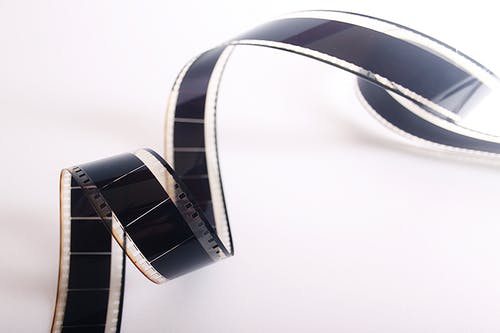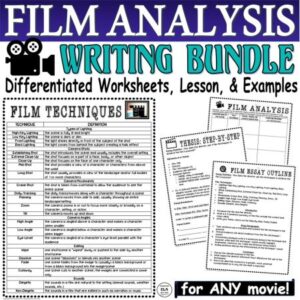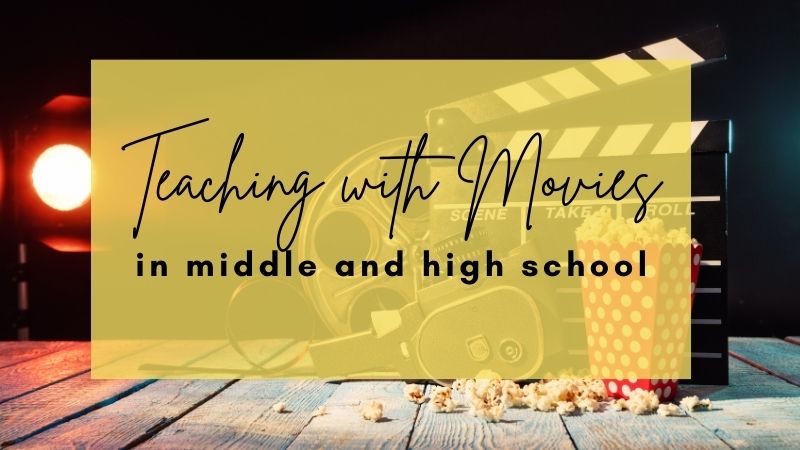Teaching with movies can be fun, yet tricky in the classroom. Maybe it is the end of the year with testing finally completed after weeks and weeks of state exams. Or maybe you are two days from Winter Break, and YOU just need a break… Instead of starting something entirely new, you simply want your students to watch a movie. It can be tempting, but when an administrator stops by, it can be hard at times to justify.
Most administrators might see students watching movies and think the teacher is trying to avoid teaching. Instead, think of teaching with movies as a vital part of the educational experience!
Keep reading to get ideas for teaching with movies!
Need help with Test Prep? Check out this FREE Pack of 3 Test Prep Activities to help students achieve success on standardized tests!
Teaching with MOVIES in 5 WAYS:
Most students watch more television shows and movies nowadays than read books. I am NOT saying this is good or bad, but it is true. Teaching with movies helps us see stories, and let’s face it, they are fun to watch! Their impact is undeniable. (I think we all have a top ten list of movies we would take with us to a deserted island…) One of the biggest issues with watching movies seems to be that students don’t tend to truly examine what they are viewing. So let’s give them something to think about and critically analyze as we start teaching with movies!

1. TEACH MOVIES AS TEXTS:
My NUMBER ONE way to use movies is to think of them as reading texts unto themselves. Some movies take years to create, produce, and present to the general public. Many of them have something valuable to say about culture, identity, values, patriotism, responsibility, etc. Because of their noteworthy and diverse ideas, we can teach through movies as texts in several ways.
Theme
Every movie has a message, so teaching theme can be enjoyable and engaging. You can use entire movies or small clips. Remember though, analyzing themes requires students to discern the entire message, not just a topic. For example, “love” is not a theme. “Love requires sacrifice” is a theme. Click here for a THEMES MADE EASY Activity Pack!

Characterization
As you watch a film, students can also analyze how a character changes from start to finish. You may need to help students identify traits of that character at the beginning.
Be sure to model how to locate support from what the character says or does or even how the director depicts the character. After they gather their evidence, students can write about how that character changes from the beginning to the end of the film.
Mood
For a more basic approach, you could have your students examine the mood of different parts of a movie or how mood changes within a single scene. We all know that some stories start with a lighthearted, fun-filled atmosphere and quickly devolve into a horrifyingly chilling mood. The biggest element of teaching mood is having students examine HOW mood is created. You will want to encourage students to note what they see throughout the film to support the mood. (*Try out Alfred Hitchcock’s Rear Window, Notorious, or Lamb to the Slaughter for AWESOME mood analysis!)
https://www.teacherspayteachers.com/Product/Distance-Learning-Google-Classroom-Movie-Activities-Film-Analysis-Worksheet-Mood-5792953?utm_source=Blog%20Post%3A%20Teaching%20With%20Movies&utm_campaign=Blog%20Post%3A%20Teaching%20With%20Movies
Other AWESOME Scenes to Analyze for THEME, CHARACTERIZATION, and/or MOOD:
Edward Scissorhands: Ice-Carving scene near the end of the movie
Rear Window: Opening scene with the view of the apartment complex
Jaws: Beginning scene with the girl on the beach
12 Angry Men: Last scene before the verdict
To Catch a Thief: The car chase
Raiders of the Lost Ark: The beginning scene with the idol and boulder
Back to the Future: The prom
Forrest Gump: The Run-Forrest-Run scene
West Side Story: The school dance
Singin’ in the Rain: The dream sequence near the end
Ben-Hur: The chariot race
Rocky: The steps scene
To Kill a Mockingbird: The courtroom scene with Mayella
Jurassic Park: When the characters first see the dinosaurs
THIS BUNDLE BELOW OFFERS EASY-TO-TEACH ACTIVITIES FOR WHEN YOU WANT TO ANALYZE A MOVIE!
2. TEACH MOVIES AS PARALLEL TO ANOTHER TEXT:
Another way to teach a movie is by pairing it with another text. For example, you could have a short story and connect it to the movie version. You could also have students compare and contrast major ideas from a traditional fairy tale like The Little Mermaid to a movie version. Be prepared with an actual assignment though. Simply sitting students in front of the screen and afterward discussing the movie and text is NOT the purpose. We MUST have a goal in mind. Check out some assignment ideas for teaching PAIRED PASSAGES:
- Socratic Seminar
- Short Writing Exercise
- Film Analysis Essay
- Presentations
- Story Response
Here are some awesome movie pairings:
- To Kill a Mockingbird movie and book
- 12 Angry Men and To Kill a Mockingbird book
- Pretty much ANY Disney movie and the original fairy tale
- Romeo and Juliet movie (even the Leo version) and the play
- Serenity and 1984 (Dystopic Literature)
- Equilibrium and Brave New World (Dystopic Literature)
- Othello movie and play
3. TEACH MOVIES AS ELEMENTS OF HISTORY:
For using film to teach about history, you have to be careful. Some movies massively depart from the actual time period in terms of language, values, technology, etc. Now, Pride and Prejudice as well as Little Women both have film versions that, on the whole, adequately illustrate the time period. Other films like Pride and Prejudice and Zombies or anything dystopic merely connects on a surface level, but they are not supposed to accurately illustrate a real time period. You could focus on these ideas and compare/contrast the film to other depictions from similar or even different time periods.
4. TEACH MOVIES THROUGH FILM TECHNIQUES:
I love having students examine FILM TECHNIQUES while teaching with movies. Like poetry, short stories, plays, and novels, movie directors utilize various techniques to convey the story. Once students begin to see these techniques, they won’t be able to escape into movies like they did before. Instead, they will see purpose beyond what is happening. They will look into how the director constructs the film and see the film more deeply instead of merely accepting it without thought.
Here are some FILM techniques you could have students analyze FOR TEACHING WITH MOVIES:
-
- Types of Lighting
- Camera Shots
- Camera Movements
- Camera Angles
- Editing
CLICK THE ESSAY PACK BELOW FOR HELP WITH TEACHING FILM ANALYSIS!
5. TEACHING WITH MOVIES AS RHETORICAL ANALYSIS:
Documentaries are the BEST for teaching movies as a source of rhetorical analysis. The best documentaries leave the audience guessing who the director sides with. They present both sides of the argument with interviews and stories from many sides. There are so many films on politics (be careful with this), health, sports, etc. that students can examine rhetorically.
You can teach rhetorical appeals within these films as well as the entire rhetorical situation, as any movie can be viewed through the lens of RHETORICAL ANALYSIS! Check out these appeals you could have students focus on as you begin teaching with movies:
-
- Logos- an appeal to the audience’s rational thought by using facts and statistics
- Pathos- an appeal to the audience’s emotions through the use of emotional language
- Ethos- an appeal to the audience through a belief in the speaker’s authority
CLICK HERE>>> TEACH HOW TO WRITE A RHETORICAL ANALYSIS ESSAY STEP BY STEP
Why teaching with movies can be fun and effective…
By teaching with movies in your classroom, your students will grow in their reading comprehension, writing skills, and critical thinking. Integrate teaching with movies, and your students will thank you EVERY time!
By Kristin Menke-The Integrated Teacher
Check out my shop for help with teaching with movies: Integrated ELA Test Prep!





